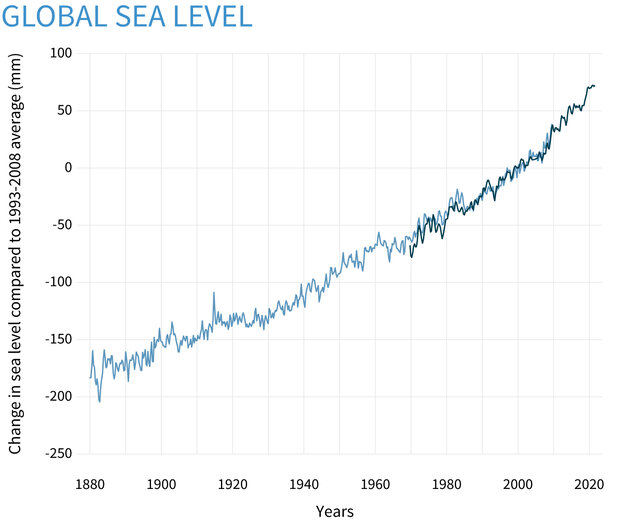- At face value, rising sea levels are the most credible of climate change concerns.
- But sea level rise is a problem for humans, with or without climate change driving it.
- Society has many affordable solutions to the problem.
Sea level rise is perhaps the most plausible threat from climate change. The risk comes from thermal expansion of water and the melting of glacial ice sheets in Greenland and Antarctica, in which vast volumes of frozen water are locked. The idea that a warmer atmosphere will cause more ice to melt, and for this water to contribute to sea level, which may in turn inundate coastal cities and towns, is easy to understand and its consequences are easy to imagine. This explains its centrality in arguments for urgent climate policy. But often, stories that make intuitive sense and which appeal to our imaginations are exaggerated, as are the risks that such stories imply.
In the last decades of the twentieth century, stories of runaway climate change led people to believe that SLR was an imminent problem, which could submerge even inland cities. Articles claimed that by the early part of this century the world would have warmed by 11°C, and sea levels would be six metres higher. Many commentators, including scientists, prefer to give emphasis to extreme global warming scenarios that produce dramatic rates of SLR. But since the first IPCC report, scientific projections for sea level rise by the end of the twenty-first century have been consistently based around the 1-metre mark.
That may sound like something worth protecting the world against, and it is certainly no trivial problem at face value. But it has to be understood that SLR is a fact of life with or without a contribution from global warming, and that it is a problem in its own right to which coastal countries need to respond. SLR may not be a problem that is going to be solved by emissions reduction policies easily, if at all. As the following chart produced by NOAA shows, the global sea level has been rising since long before the era of global warming.

Some analyses of sea level data suggest that the rate of SLR has accelerated from 1.4mm per year to about 3.6mm. Even at this rate, there will be just one foot (30cm) of SLR by the end of the century, compared with sea level in 2000. This is very far from the apocalyptic scenarios that dominate much coverage of the climate issue. And rather than being lost to the sea, one recent study showed that the planet had gained 173,000 km2 of land over the last 30 years.
One of the problems troubling rational debate about the link between climate change and SLR is that sea level is extremely difficult to measure. No part of the sea is either representative or stable enough to take measurements from. Waves and tides prevent a static reading. And land itself moves either up or down at long timescales, as a result of geological forces, such as landmasses’ ongoing recovery from the last ice age, and changes in land use and water abstraction. Many coastal areas are rising, and many are sinking. Some datasets prefer to use measurements from satellites instead, but these too are prone to error, and suffer from only covering relatively recent history with any precision.
SLR is therefore something that many countries and coastal towns and cities need to adapt to, whether or not global warming is influencing it. But the good news, in contrast to the alarmist narratives that dominate public discussion, is that SLR is not a problem that we have no means to cope with. Since the middle ages, large parts of the Netherlands have been reclaimed from the sea; Amsterdam exists quite comfortably and safely at 2 metres below sea level.
The UK Committee on Climate Change estimates that the cost of adaptation to sea level rise to 2100 would be just £6.4 – 9.2 billion, less than the UK’s annual subsidies to renewable energy generators. Similarly, studies on global adaptation to even abrupt and extreme rates of SLR that are outside the IPCC’s central estimates suggest that the cost would be in the low tens of $billions per year – a figure that is, on the face of it, large, but again, relative to the costs of climate change mitigation that taxpayers and consumers are already paying, very little. This demonstrates the fact that adaptation to rising sea levels is the far more sensible response to climate change than climate mitigation.
